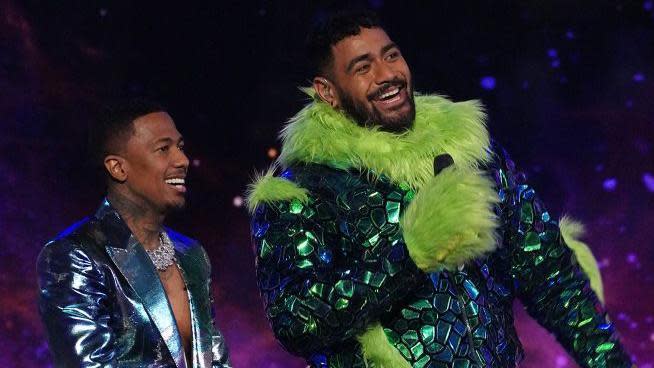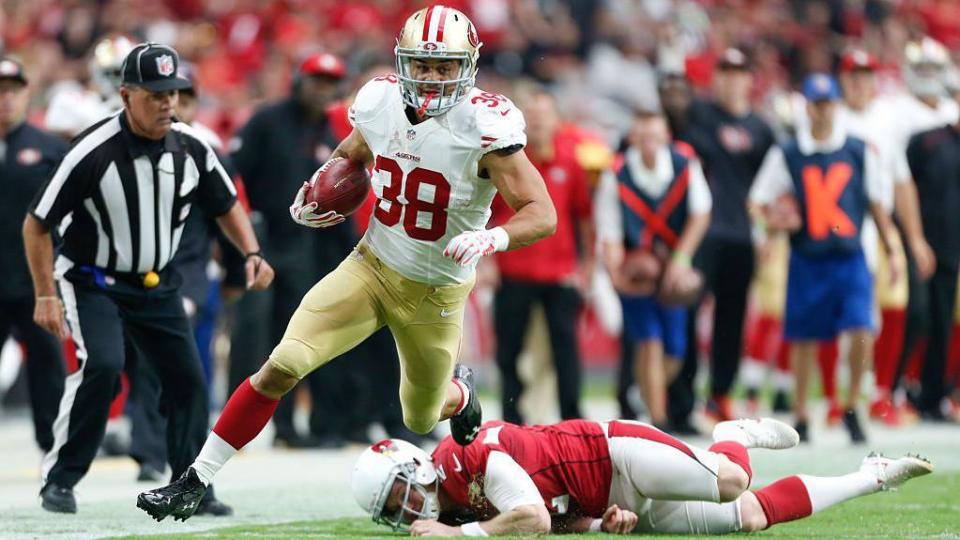


Louis Rees-Zammit and Travis Clayton are the latest players to have quit rugby to pursue a career in the NFL.
It has proved a difficult task. Only Jordan Mailata has managed to make the transition.
“It recalibrates what you think is hard,” says Christian Scotland-Williamson, one of those who missed out.
So as Rees-Zammit and Clayton prepare for the next stage of their NFL adventure, what can they learn from their predecessors?
Here’s a reminder of those who chased their American dream.
Like Rees-Zammit, Christian Wade has pace to burn and quit rugby in his prime. He was 27 and third on the all-time Premiership try-scorers list when he left Wasps in 2018.
After going through the International Player Pathway (IPP) in 2019, he trained with the Buffalo Bills and made an instant impact in their first pre-season game.
On his very first carry in American football, Wade burst through the Indianapolis Colts‘ defence to run in a stunning 65-yard touchdown.
He played in two more pre-season games but spent the next three seasons on the Bills’ practice squad. That sensational start was as good as it got.
Wade returned to rugby in 2022 with French side Racing 92 and is now back in England, coincidentally helping to fill the void Rees-Zammit left at Gloucester.
Christian Scotland-Williamson was playing for Worcester when he produced a crunching tackle that went viral.
Among those to reach out was the NFL and months later he was working up to 17 hours a day on the IPP programme in 2018.
He joined the Pittsburgh Steelers and played in pre-season as a tight end, but ill-timed injuries scuppered his progress and he was released after three seasons on their practice squad.
He briefly returned to rugby before becoming a barrister, but insists he wasn’t looking at rugby as a Plan B.
His advice is: “You’ve got to burn the ships behind you. You can’t think ‘Oh, I’ll go for a bit then come back’.
“The odds are so stacked against you, you can’t have the slightest thought of the comfort waiting for you at home.”
After stints with Newcastle Falcons, London Irish and Yorkshire Carnegie, Alex Gray joined the inaugural IPP class in 2017.
He joined the Atlanta Falcons and played in pre-season as a tight end, but after three seasons on their practice squad, Gray was released and briefly returned to rugby with Bath.
Today, you’re more likely to see him in spandex than shoulder pads as he earned a spot on the newest version of BBC TV series Gladiators as Apollo.
Despite growing up in Australia, Hayden Smith discovered rugby in America after completing a basketball scholarship there.
He went on to play for Saracens and the USA, and after playing in the 2011 Rugby World Cup, he had workouts with five NFL teams.
He played in one regular season game for the New York Jets in 2012, making one reception for a 16-yard gain.
It proved to be the one and only NFL pass he received as Smith was released in 2013 and returned to rugby.

Jordan Mailata grew up playing rugby league and had reached the South Sydney Rabbitohs’ Under-20s, but there were continued concerns over his conditioning.
That’s when he received surely the best advice he’s ever had: “Why don’t you play a sport that appreciates your size?” At 6ft 8in and 365lb (166kg), that sport was American football.
“His agility and speed for a person of his size, who hadn’t grown into his full frame yet, it was so impressive,” says Scotland-Williamson, who was on the IPP programme with Mailata in 2018.
Aged 20, the Australian was drafted by the Philadelphia Eagles and although he spent two seasons on their practice squad, he then became one of the NFL’s best offensive tackles and helped the Eagles reach the Super Bowl in 2023.
Travis Clayton became the second IPP player to be drafted and Scotland-Williamson – a groomsman at Mailata’s wedding last year – reckons that bodes well for the 6ft 7in offensive lineman who weighs 301lbs (137kg).
“With the bigger body types in the trenches, you’ve got more chance of making a late transition [to the NFL] because you can’t really grow athletes that big, and they’re hard to find,” he says.
“Also, being drafted means more. People want to see their decision proved right because they’ve invested draft capital in you; they’ve stuck their neck out, so you’ll get more patience.”


Valentine Holmes didn’t last a season on the Jets’ practice squad in 2019 before returning to Australia – and before the IPP was launched, another rugby league star from the NRL had to forge his own path to the NFL.
The San Francisco 49ers signed Jarryd Hayne in 2015 and he did so well in their pre-season games that he featured in their season opener.
He had a poor start, fumbling his first punt return, but across eight games he made some positive plays as, like Rees-Zammit this pre-season, he was used in a variety of roles.
But the 49ers then changed coach and Hayne returned to rugby in 2016 because learning the new playbook would “take too much time”.
Scotland-Williamson can empathise. He says studying the law books required to pass the bar was easier than learning an NFL playbook.
Now Rees-Zammit’s chances depend on “how quickly he gets up to speed with the playbook” having just switched teams, but Scotland-Williamson feels the former Wales wing could be used in a similar way to Hayne.
“He played eight games without the IPP, as a kick returner and a specialist, and that’s where you can avoid the 10,000 hours’ gap of practice with the technical side – the routes, the timings, being able to spot holes from the backfield. They’re the things that take time to learn.”
Scotland’s Jamie Gillan and Kiwis Stephen Paea and David Dixon all played rugby in their youth before making it to the NFL via the US college system.
Kenya’s Daniel Adongo deserves a mention for playing rugby in South Africa and then playing twice for the Indianapolis Colts in 2013.
And who could forget Lawrence Okoye? After playing rugby at high school, Okoye represented Great Britain in the discus before having a shot at the NFL.
Between 2013 and 2017, he spent time with six teams as a linebacker without playing a regular season game.
He is now back in athletics but his departure from the Arizona Cardinals – head coach Bruce Arians said that Okoye was cut for using his parking spot – should serve as a warning to Rees-Zammit and Clayton.